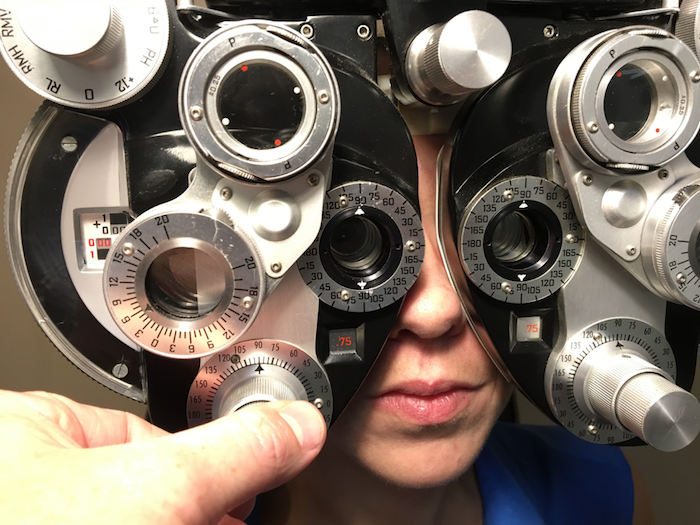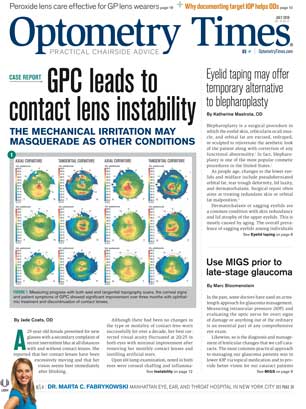3 tips to upgrading astigmatic contact lens patients
Helping astigmatic patients see more clearly can an exciting part of fitting contact lenses. There is significant value to the patient and to the practice in correcting low astigmatic patients.

New technology looks great and is exciting to touch, feel, and experiment with. Unfortunately, many optometrists routinely forget about new technology and fall back into our comfort zone with contact lens fits.
Consider taking a step back to look at how you are attacking certain contact lens situations. You may find there is a better way of doing things.

Figure 1A.

Figure 1B.

Patient education first
Many patients do not have a solid understanding of astigmatism. Some patients even associate the word with a disease state.
When talking with patients, do not assume they understands astigmatism-explain that astigmatism is simply a different way of focusing images. Educate your contact lens patients that having astigmatism requires them to utilize a contact lenses designed to meet their visual needs.
Figure 1A and B. Look across the parking lot. If upon exiting your practice, a patient experiences poor vision with contact lenses (Figure 1A-Top) as compared to a sharp image (Figure 1B-Bottom), she may lose confidence in your abilities.
Our astigmatic patients often receive spherical equivalent lenses prescribed in order to mask their cylinder. This practice began back in an era when not many toric lens options were available and those options were not stable on the human eye. Uncorrected astigmatism results in distorted or blurred vision and a loss in “sharpness” of visual acuity. This can lead to headaches and eye fatigue.
Related: 5 methods to drive contact lens compliance
Fortunately, we work in a different contact lens era with better material and design technology. For astigmatic patients previously wearing a spherical lens, consider upgrading them to a toric contact lens.
Following are three tips to help.
1. Minimize masking
When patients are judging the care we provide, they do so based on how well they see with their vision correction, whether it is eyeglasses or contact lenses. When they walk out the door and look across the parking lot, they want to see the best the possibly can.
If there is a technology that provides better vision, our patients will desire that option. You may want to mention the time period for their contact lenses to settle and for their vision to stabilize so your patient does not grow frustrated with the fitting process.
Due to the success of today’s toric contact lens designs, there is no longer a good reason to mask astigmatism. Masking cylinder with spherical contact lenses does not allow the best visual outcome. If there is any doubt with those 0.75 D cylinder patients, demonstrate the cylinder correction in the phoropter and ask which the patient prefers to have in his contact lenses. Additionally, demonstrate the cylinder axis. Explain that this contact lens has variable powers that have to be perfectly lined up in order to provide the best vision possible.

2. Remember that toric contact lens parameter options have grown exponentially
ODs can grow new contact lens wearers because many astigmatic patients have been told contact lenses are not an option for them. I’m not sure why some doctors are still spreading that rumor.
Contact lens options in multiple modalities are available for just about everyone. Proactive contact lens practitioners realize that.
New materials and modalities may provide improved ocular health and convenience. Your patients need to be aware of this. Silicone hydrogel toric lenses offer improved oxygen permeability, and daily disposable toric lenses offer a viable option for part-time and full-time wearers looking for better convenience.Figure 2.Take a few seconds to demonstrate vision with and without cylinder correction and listen to your patient’s response. Demonstrating the uncorrected astigmatism over the patient’s current spherical prescription is a powerful tool.
By offering patients an option that may not have been presented to them in the past, forward-thinking practitioners will tap into a new market of contact lens wearers.
Related: Increase contact lens comfort by paying attention to the lids
Some astigmatic patients have failed with contact lenses in the past or are just not seeing as well as they could be and are skeptical to try something else. These patients may have experienced variable vision due to an unstable lens, too much lens rotation, or the specific contact lens parameters were not available.
These patients need to know that many new contact lenses options could potentially satisfy the visual and comfort requirements necessary to make them happy.
Discuss with patients how toric contact lenses come in specific prescription ranges and the fitting process helps ensure their astigmatism power and axis (already demonstrated behind the phoropter) are lined up perfectly for their vision. This helps set the stage for them to understand their contact lens prescription may be a little different if compared to their spectacle correction but is customized for their eyes.
3. Don’t forget about enhanced comfort
With many patients spending their workdays in front of a computer, dry eyes at the end of the day due to digital eye fatigue is a growing concern. ODs can help address this challenge.
Start by asking your patients how many hours they spend each day in front of the computer. Next, ask them when their contact lenses begin to dry out and/or their vision becomes unstable.
Discomfort and blurred vision usually start midday. Increasingly, all patients (from kids to adults) are spending more time in front of a screen, and contact lens-related comfort must be addressed at every visit. Opening the door to a conversation of computer or digital device usage enables optometrists to discuss options like daily disposables contact lenses and silicone hydrogel materials.
I tell patients, “We have new, improved contact lens options, and these lenses remain moist, allow more oxygen to your eyes, and can improve your end-of-day comfort, especially if you are spending more and more time in front of a computer screen."
Related: Managing the astigmatic patient with contact lenses
Additionally, all contact lens brands are not created equal in that all vary in their modulus, oxygen permeability, and edge design. All of those factors, along with the patient’s ocular health and environment, go into the patient’s perception of comfort with contact lens wear.
Help your toric patients
Helping astigmatic patients see more clearly can an exciting part of fitting contact lenses. There is significant value to the patient and to the practice in correcting low astigmatic patients. We may be able to eliminate many patient concerns by correcting even low amounts of astigmatism.
Use cylinder power and axis demonstrations to enhance the fitting process. Such demonstration further illustrates your abilities and helps patients understand the importance of stability in their contact lenses and the value of your contact lens fitting.
Improved toric contact lens designs allow your office to provide a differentiated product. Give your patient the option to see more clearly.
Get more toric contact lens content by visiting our Toric Contact Lens Resource Center

Newsletter
Want more insights like this? Subscribe to Optometry Times and get clinical pearls and practice tips delivered straight to your inbox.